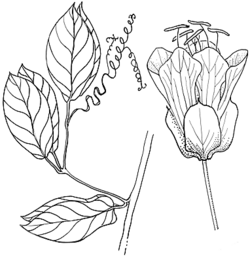Common name: Cup-and-saucer Vine, Cathedral Bells, Mexican Ivy, Monastery Bells
Cobaea scandens Cav. APNI* 
Description: Herbaceous perennial, rapidly growing climber with branches usually 3–8 long.
Leaves pinnate with basal pair of leaflets ± sessile; leaflets opposite in 3 or sometimes 2 pairs, 3–13 cm long, 1–6 cm wide, apex mucronate, margins entire, glabrous; tendrils (modified terminal leaflets)branched, up to 5 cm long; petiole c. 1 mm long; petiolules 5–20 mm long; stipules absent.
Flowers 3–4 cm diam., peduncles 8–30 cm long. Calyx broad, 3–3.5 cm long, tube short, lobes ± ovate, green. Corolla campanulate, 4–6.5 cm long, green turning violet-purple; lobes shorter than tube. Stamens exserted by c. 20 mm; anthers c. 10 mm long.
Capsule ellipsoid to oblong, 5–9 cm long; seeds numerous.
Flowering: most of year.
Distribution and occurrence: cultivated as an ornamental, occasionally naturalised in the Sydney region as well as recorded from the far north-east coast of New South Wales. Native of tropical Americas.
NSW subdivisions: *NC, *CC
Cobaea was formerly in the family Cobaeaceae.
Text by S.M. Hastings, Flora of New South Wales Vol. 3: 384 (1992), in Cobaeaceae; updated by P.G. Kodela, March 2017
Taxon concept: Australian Plant Census (accessed March 2017)
APNI* Provides a link to the Australian Plant Name Index (hosted by the Australian National Botanic Gardens) for comprehensive bibliographic data
***The AVH map option provides a detailed interactive Australia wide distribution map drawn from collections held by all major Australian herbaria participating in the Australian Virtual Herbarium project.
|


